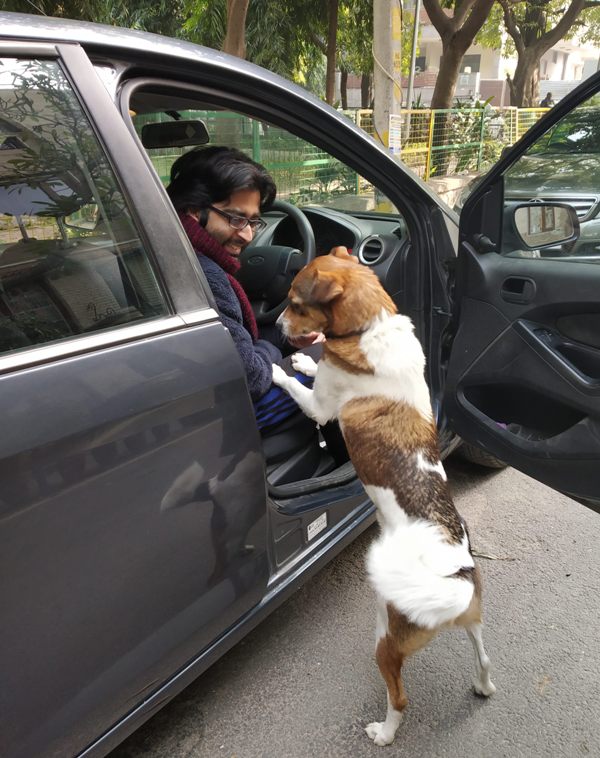
I am a community dog feeder and caregiver in New Delhi, India. I am loved by many dogs and potentially disliked by many humans — maybe not in practice, but definitely in theory. I am the kind of person who is told, “If you like street dogs so much, why don’t you take them inside your house?”
Dog feeders often choose to carry out their entirely voluntary and physically, emotionally, and financially taxing feeding duties in the cover of darkness — either early in the morning or late at night. Just like the dogs we feed, we too are scared.
We’re scared that we might be stopped by those who have been tagged the “silent suffering majority” (i.e. those who want the dogs removed immediately from the streets of Delhi-NCR) at a recent Supreme Court hearing, from doing what Article 51A(g) of the Indian Constitution mandates: “…to protect and improve the natural environment including forests, lakes, rivers and wildlife, and to have compassion for living creatures.”
Let’s face it. Animal well-being has never really been a popular cause to stand up for. How can it be?
If there are no humans involved, it’s a non-issue, right? After all, wasn’t this world created just for us, with the other living beings merely incidental? I honestly don’t understand people who think along these lines, but I do want to change them — gently, lovingly, without any altercation or confrontation, with dialogue and discussion.
I want to talk to them and tell them that the first emotion that takes hold of you when you see a dog on the street should not be fear.
According to a recent University of Edinburgh study, only 2 per cent of interactions between human beings and street dogs in India are aggressive. Credible news reports have shown that, in the past two decades, the number of reported human cases of rabies in India has fallen by almost 75 per cent. Mass dog vaccination drives are working.
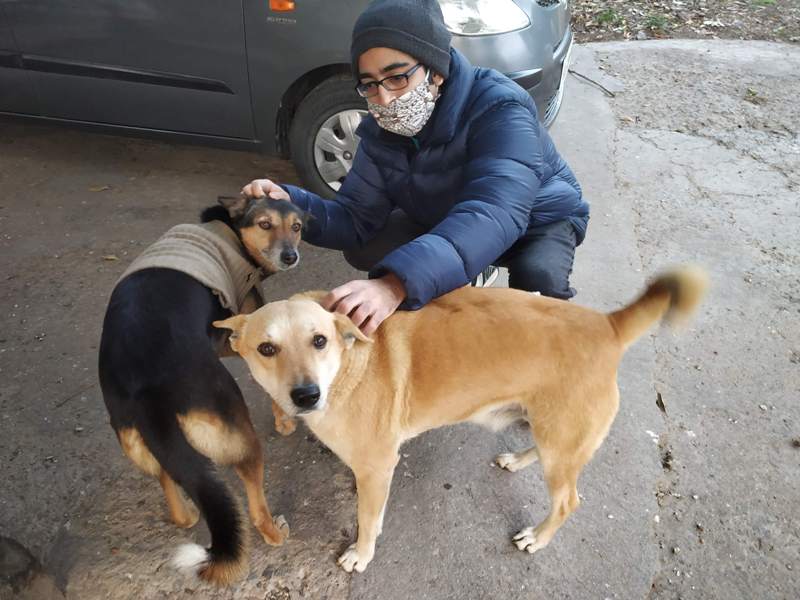
Don’t be scared of street dogs
A stray dog on an Indian street is likely to be hungry, possibly injured and most probably very, very scared.
He/she might not know any better than to snarl and growl, because all it has received from this unforgiving world is hate and potential abuse. But just a little bit of compassion, a few kind words, some food and water will prove to it that I am a friend and not foe, that I am there to help and that we can both co-exist. And that might just be the beginning of a beautiful relationship.
Remember, just like most human beings, dogs too choose flight over fight when their safety is threatened. Snarling, baring of the teeth, barking etc are aggressive techniques that they adopt when they feel they are in danger, when they are scared or unsure.
Unsure is incidentally also what the entire animal-lovers’ community in Delhi-NCR is right now. The August 11 Supreme Court suo motu directive, which asked for the complete removal of street dogs in Delhi, Gurugram, Noida and Ghaziabad and forced confinement in shelters within 6-8 weeks, sent shockwaves across the country.
We are all now waiting anxiously to see what the order is from the three-Judge bench that was constituted by the Hon’ble Chief Justice of India. This bench heard a plea on August 14 against the earlier directive. As of now, the order is reserved and the matter is sub judice.
Trust me, just like many people who don’t have any time for animals, no dog caregiver wants to see hungry, pathetic dogs on the streets, living at the mercy of the often merciless. We want better lives for them, often bringing them into our own homes, like my in-laws and my wife and I have done, with two of our community dogs.
Also, let’s be brutally honest: do we really have proper shelters to take these dogs to? Not at all. It will take years, possibly decades to construct habitable shelters for all our dogs. Plus, where is the money for this entire exercise going to come from?
Should dogs who are already well-settled in localities they are familiar with be relocated at all? Absolutely not. Relocation of dogs never was and can never be the answer. If this happens, countless dogs — many are well taken care of by willing citizens and very far from being aggressive — will die. There’s no doubt about that.
These are living beings, many of whom live in appalling conditions because of our collective failures as a society. Also, we must remember that Delhi is currently facing a huge garbage disposal crisis. Let’s not, for one minute, think that if all current dogs are removed that will be the end of it all. New dogs from surrounding areas will soon make their way into the city and replace the old ones, because there is easy access to garbage — something most street dogs live on, as scavengers.
Let’s not allow some people to paint our street dogs as vicious, blood-thirsty creatures. They want to co-exist with humans much more than the other way round.
No one wants human-animal conflict; no one wants children to be hurt in any way, let alone by creatures who we all know can be kind and loving. A human being bitten by a dog and a dog being beaten up are both very avoidable. Sterilisation is the key.
Look at Bhutan, for instance — a country that has achieved 100 per cent sterilisation of dogs. According to a report in The Print, in India itself, cities like Lucknow and Vadodara have achieved over 80 per cent sterilisation, while the population of street dogs has fallen by 40 per cent since 2016 in Dehradun.
I see first-hand what one square meal a day means to these voiceless, vulnerable and often vilified creatures. Living creatures who breathe, feel, sense, observe, register and suffer — a lot like us, you might say.
They are almost always scared and on edge and yet their love is not transactional. Try and observe the eyes of dogs who live on main roads and busy pavements, without any shelter whatsoever, when you can. Their eyes are usually always darting from side to side, ever wary of the next kick, the next stone, the next insult, the next car that won’t stop even after the driver has spotted the wagging tail and the furry body. Forever living on a prayer.
Three dogs of Kolkata
On a recent visit to Kolkata, I noticed three dogs who made me pause, reflect and take out my phone to take photos to send to my wife, Aruna.
The first was an adorable black, white and brown dog sleeping inside a Kali Mandir (Lake Kali Bari) on the cool marble slabs that have names of benefactors and donors inscribed on them.
This is a place of worship and a dog had not just been taken in by the temple staff, but he/she was also allowed to sleep next to the shrine itself.
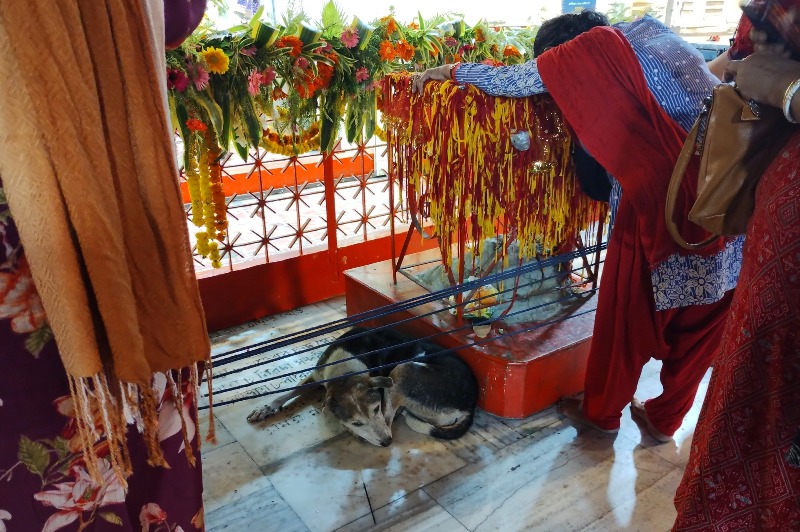
The dog was clearly well-fed and feeling secure enough to have absolutely passed out — blissfully unaware of the hordes of devotees, temple staff, beggars, tea stall employees, customers, shrieking kids, passersby and the constant, rather loud sound of non-stop traffic (this temple is on an arterial road).
You would’ve come across similar sights in other Indian cities, too, I am sure, at temples, burning ghats, busy marketplaces, bazaars etc. Being kind to animals is something that is — or at least, was — a highly valued facet of Indian culture.
The second dog I spotted who made me pause was lying right at the entrance of Victoria Memorial, inside the main gate, absolutely passed out. This, for me, was an even stranger sight.
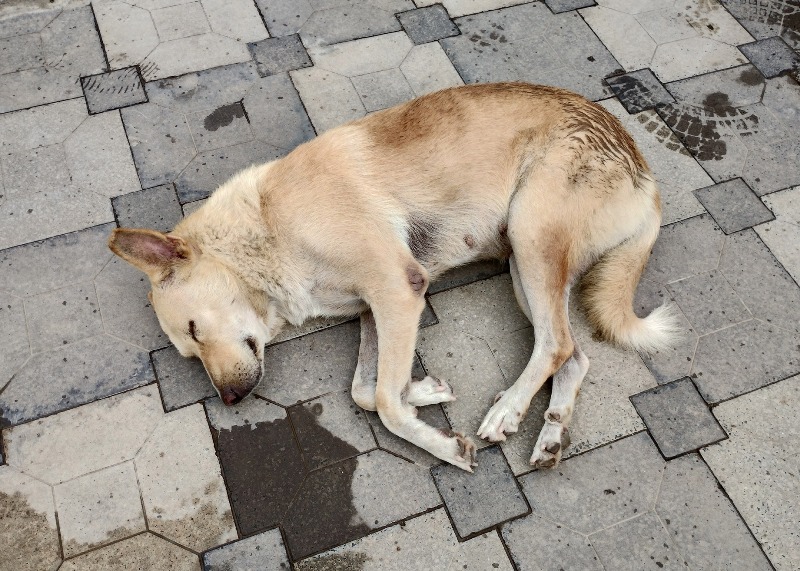
I’ve seen many dogs in Delhi marketplaces sleeping soundly in a sea of people, but this was an ocean! Victoria Memorial is the No. 1 landmark in Kolkata, and gets hundreds of visitors all day, every day.
You can imagine how many people there were, at the time, queuing up to enter this huge tourist attraction. Not a single person was either scared of the dog or wanted it to be moved. The police men and women who were at the gates were clearly more than happy to have this dog there, even though everyone was having to skirt around it to go past.
This dog too was clearly well-fed (no bones showing and comfortable enough to fall asleep there). The food must come from the people who work there.
The third one on this list was another one who really values his/her siestas. Lying on his/her back, with legs pointing skywards, clearly airing the belly — and more importantly, feeling secure enough to do so, as dogs only expose their stomachs when they’re feeling totally safe.
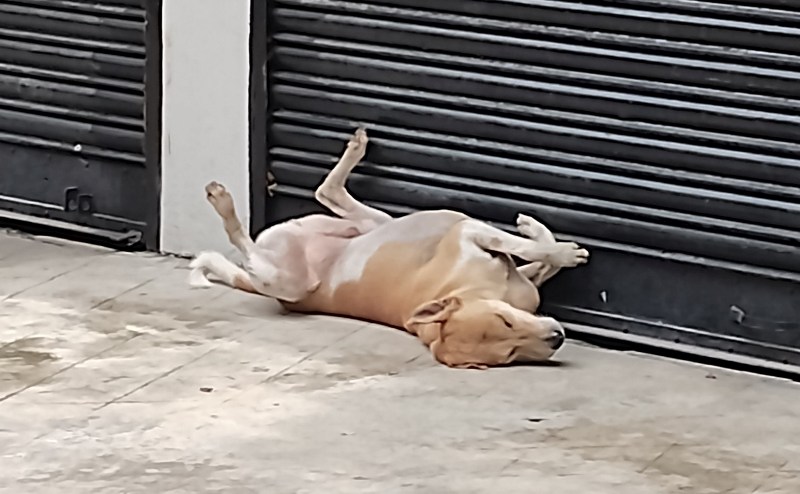
This was right outside my Dida’s (maternal grandmother’s) house and as I found out later, a lady in the house across the road feeds about 4-5 street dogs every day, including sleeping beauty here. No wonder he/she was so peaceful —well-fed and loved.
We can co-exist with street dogs
By now, it’s well-known what most people with a compassionate heart feel about the August 11 order.
The argument in the Hon’ble Supreme Court has been that cases of dog bites are on the rise, but as senior advocate Abhishek Manu Singhvi, arguing against the August 11 directive, told the SC during the August 14 hearing, the senior advocates arguing in favour of the August 11 order had “created pre-emptive prejudice”.
Singhvi said, “The government in Parliament has answered that there have been zero cases of dog bites in Delhi this year.”
Also, let’s not forget just how useful these ‘stray’ dogs are. They act as security guards at night; faithful companions of the elderly; often playmates for the very young; and on a more practical level, dogs, along with cats, contribute heavily to rodent control in cities, especially rats — who by the way, can also carry the rabies virus and can also cause rat-bite fever, apart from other civic devastation.
Community dogs, protecting their turf, also ensure that no new dog comes into a locality, as such, thereby ensuring, to a certain extent, a check on dog population in that area.
Most dog caregivers have a fixed number of dogs (which change when older dogs die and others join the existing packs etc). These dogs, who are regularly taken care of, are mostly all sterilised.
Most, if not all, dog feeders and caregivers in India spend money out of their own pockets to feed, vaccinate, sterilise and medicate the dogs they take care of.
Preparing and portioning out the food for all the dogs we take care of is a mammoth exercise performed each day, without fail, by my mother in-law.

Sterilisation and vaccination of street dogs is ideally the job of the civic authorities. The ABC (Animal Birth Control) rules 2023, under the Prevention of Cruelty to Animals Act of 1960, clearly stipulate everything that needs to be done so that dog population is kept under check and thereby to minimise animal-human conflict.
According to a Reuters report, India has 5.25 crore (52.5 million) stray dogs, as per a State of Pet Homelessness Survey by Mars Petcare. The number of street dogs in Delhi alone is being quoted as somewhere between 300,000 and 100,000.
According to a Hindustan Times report from October 2009, the non-government organisation Wildlife SOS conducted a survey for the Municipal Corporation of Delhi (MCD) between January and September that year, covering all 12 zones of the city of New Delhi, which are further divided into 250 wards, as well as the Delhi Cantt and New Delhi Municipal Council areas. This exercise was essentially conducted because the 2010 Commonwealth Games were around the corner.
The number that Wildlife SOS had reported at the time was 260,000 dogs. According to media reports, there has been no full city-wide census conducted since this one in 2009, about 16 years ago.
In other words, if we hypothetically say that the population of street dogs in Delhi currently is 800,000, that’s more than three times the number in 2009.
This population increase is despite the fact that a large number of dogs, often puppies, are killed in road accidents, beaten to death, picked up and thrown into cages, and kept in absolute squalor where they eventually die. Some are also sold and/or adopted as pets, etc.
Are we demanding answers from those who are supposed to carry out the civic duties of keeping the dog population under check, but are not? As of now, these civic officials are not being held accountable for their abysmal failures.
In the absence of any government support, civilian feeders often ensure sterilisation of dogs themselves, which in turn helps keep the dog population in an area/locality in check. In the locality we stay in, the dog population has, in fact, come down from roughly nine some years ago to four at present.
Residents’ Welfare Associations (RWAs) in Delhi-NCR should ideally work closely with animal feeders and ensure sterilisation, vaccination and responsible feeding practices at identified feeding spots.

Well-fed and cared for dogs are generally docile and don’t pose any danger to humans. Animal NGOs work tirelessly with the aid of unpaid volunteers to try and ensure that the dog population doesn’t go through the roof. But it’s a very tough thing to accomplish when they receive little to no support from the authorities.
Overall, many stumbling blocks
According to an NDTV report, the Municipal Corporation of Delhi has earmarked just INR 108.43 crore for veterinary services in its proposed 2025-26 budget — this is a very meagre 0.64 per cent of the total planned MCD expenditure.
In 2015, the well-known animal welfare NGO, Friendicoes, established in 1979 in Delhi, was on the verge of shutting down because it just didn’t have funds. At that time, according to news reports, the municipal corporations owed the NGO INR 38 lakh, while their own debt stood at INR 82 lakh. An online campaign managed to raise over INR 13 lakh in one day, along with other donations and the NGO — a bastion of animal welfare in Delhi-NCR — managed to survive.
Another big problem is that of abandoned pet dogs. Many people buy pedigree or semi-pedigree dogs and then realise they can’t take care of them. Many of these dogs are subsequently abandoned.
Where do the abandoned pets end up? In existing shelters, where else; this, in turn, means less space for injured and unwell street dogs or those that need sterilisation. If you keep crowding animals into shelters, in no time, they will become breeding grounds for all kinds of diseases.
There are two facts that are irrefutable. One: the stray dog population, not just in Delhi-NCR, but across the country, is exploding and sterilisation is the only answer to that problem. And two: relocation never was and never will be the answer. The “out of sight, out of mind” approach will not work here.
There’s no use dancing around the bare, ugly truth — stray dogs in India have extremely tough lives. Man forgot to take care of his ‘best friend’ a long time ago.
Some fortunate ones are taken under the wings of willing citizens via food, shelter when possible, sterilisation, medication etc. But those are a fraction of the total dog population in the country.
The Indian animal lovers’ fraternity dearly wishes that every ‘stray’ dog in the country would be a ‘community’ dog, at least — fed, protected, sterilised, loved and, therefore, not vicious, not dangerous, not worthy of being tagged a “menace”.
Not everyone will throw a stone at a dog on the street, or inflict cigarette burns on puppies, but that doesn’t mean they will actively help a dog which has just been run over by a car on a busy road.
Rounding up the dogs and stuffing them in cages will only lead to most of them dying horrible deaths. This world needs more empathy — both for humans and animals.
Let us hope and pray that history doesn’t remember the city of Delhi for a potential animal genocide.
For me, personally, the most heartbreaking sight is that of a dog who has been severely mistreated and/or hurt, still wagging its tail out of excitement (tail wagging is a form of communication and can sometimes happen when a dog is scared or anxious, too). Remember Bhadra, the dog who was thrown off a rooftop in Chennai in 2016? She was unable to walk and in excruciating pain when she was rescued, but still wagged her tail in a friendly manner.
Bhadra continued to trust humans, as do countless other dogs in India. Are we going to break that trust?


